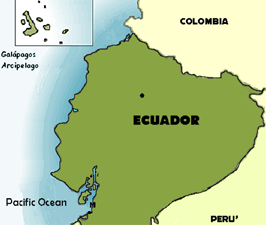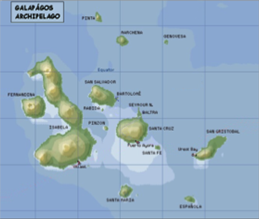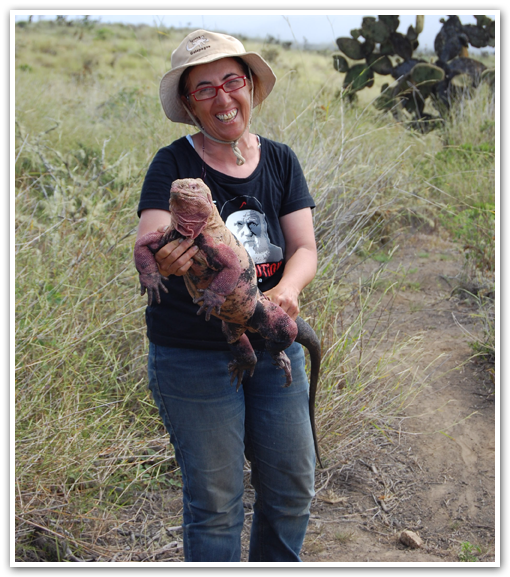Microbiota delle iguane delle Galapagos e delle tartarughe marine delle Eolie
Con lo stesso obiettivo è stato anche studiato il microbiota intestinale e l'incidenza e la natura dei determinanti di resistenza in tartarughe marine (Caretta caretta L.) campionate nelle Isole Eolie, nell’area dell’Isola di Filicudi. In questo caso sono state confrontate tartarughe in buone condizioni di salute con altre con disagi nell’alimentazione a causa di ami o buste di plastica ingeriti. Ancora, sulle stesse tartarughe marine è stato avviato uno studio pilota per valutare la struttura e la composizione dei colonizzatori del carapace: sono stati analizzati sia i macro-colonizzatori (macroalghe epifite, crostacei, ecc.) sia i micro-colonizzatori (cioè la comunità batterica) utilizzando il NGS, per cercare di definire un protocollo unitario per questo tipo di studi.
Questo lavoro è stato possibile grazie alle collaborazioni con: Gabriele Gentile del Dipartimento di Biologia dell'Università Tor Vergata, per le iguane; con Monica Blasi dell’associazione Filicudi Wildlife Conservation, di Filicudi (Messina), Daniela Mattei dell’Istituto Superiore di Sanità di Roma, e Valeria Alduina del Dipartimento di Scienze e Tecnologie Biologiche Chimiche e Farmaceutiche dell’Università di Palermo, per le tartarughe marine.
Blasi M.F., Rotini A., Bacci T., Targusi M., Bonanno Ferraro G., Vecchioni L., Alduina R. and Migliore L. (2021). ON CARETTA CARETTA’S SHELL: FIRST SPATIAL ANALYSIS OF MICRO- AND MACRO-EPIBIONTS ON THE MEDITERRANEAN LOGGERHEAD SEA TURTLE CARAPACE. Marine Biology Research, 17(7-8): 726-774. DOI: 10.1080/17451000.2021.2016840
The loggerhead sea turtle, Caretta caretta (Linnaeus, 1758), is the most common sea turtle species in the Mediterranean Sea, where it can experience severe anthropogenic impacts. Although C. caretta is known to host more than 200 epibiotic taxa (crustaceans, algae and cyanobacteria), no reports have included a detailed evaluation of the microbial community of its carapace scutes. Thus, this study aimed to determine the diversity and composition of the visible and invisible communities on the carapace scutes of wild loggerhead turtles from the Aeolian Archipelago (Southern Tyrrhenian Sea, Italy) by using a combined approach of morphological/spatial examination and molecular analyses. Altogether, our results displayed a higher abundance of crustaceans, macroalgae and Proteobacteria on the posterior carapace scutes, while Firmicutes were more abundant on the anterior scutes. For the first time, this study showed the complexity of the microbial (invisible) and visible epibionts of the loggerhead sea turtles from the Mediterranean Sea and suggests the importance of including evaluation of the microbial components when studying epibiont communities.
Di Lallo G., D’Andrea M.M., Sennati S., Thaller M.C., Migliore L., Gentile G. (2021). EVIDENCE OF ANOTHER ANTHROPIC IMPACT ON IGUANA DELICATISSIMA FROM THE LESSER ANTILLES: THE PRESENCE OF ANTIBIOTIC RESISTANT ENTEROBACTERIA. Antibiotics, 10(8): 885. DOI: 10.3390/antibiotics10080885
The improper use of antibiotics by humans may promote the dissemination of resistance in wildlife. The persistence and spread of acquired antibiotic resistance and human-associated bacteria in the environment, while representing a threat to wildlife, can also be exploited as a tool to monitor the extent of human impact, particularly on endangered animal species. Hence, we investigated both the associated enterobacterial species and the presence of acquired resistance traits in the cloacal microbiota of the critically endangered lesser Antillean iguana (Iguana delicatissima), by comparing two separate populations living in similar climatic conditions but exposed to different anthropic pressures. A combination of techniques, including direct plating, DNA sequencing and antimicrobial susceptibility testing allowed us to characterize the dominant enterobacterial populations, the antibiotic resistant strains and their profiles. A higher frequency of Escherichia coli was found in the samples from the more anthropized site, where multi-drug resistant strains were also isolated. These results confirm how human-associated bacteria as well as their antibiotic-resistance determinants may be transferred to wildlife, which, in turn, may act as a reservoir of antibiotic resistance.
Blasi M.F., Migliore L., Mattei D., Rotini A., Thaller M.C., Alduina R. (2020) - ANTIBIOTIC RESISTANCE OF GRAM-NEGATIVE BACTERIA FROM WILD CAPTURED LOGGERHEAD SEA TURTLES. Antibiotics, 9: 162. DOI: 10.3390/antibiotics9040162
Sea turtles have been proposed as health indicators of marine habitats and carriers of antibiotic-resistant bacterial strains, for their longevity and migratory lifestyle. Up to now, a few studies evaluated the antibacterial resistant flora of Mediterranean loggerhead sea turtles (Caretta caretta) and most of them were carried out on stranded or recovered animals. In this study, the isolation and the antibiotic resistance profile of 90 Gram negative bacteria from cloacal swabs of 33 Mediterranean wild captured loggerhead sea turtles are described. Among sea turtles found in their foraging sites, 23 were in good health and 10 needed recovery for different health problems (hereafter named weak). Isolated cloacal bacteria belonged mainly to Enterobacteriaceae (59%), Shewanellaceae (31%) and Vibrionaceae families (5%). Although slight differences in the bacterial composition, healthy and weak sea turtles shared antibiotic-resistant strains. In total, 74 strains were endowed with one or multi resistance (up to five different drugs) phenotypes, mainly towards ampicillin (~70%) or sulfamethoxazole/trimethoprim (more than 30%). Hence, our results confirmed the presence of antibiotic-resistant strains also in healthy marine animals and the role of the loggerhead sea turtles in spreading antibiotic-resistant bacteria.
 |
 |

Luciana mostra l’iguana rosa (Conolophus marthae), n. 100, vulcano Wolf, Galapagos, giugno 2009.

